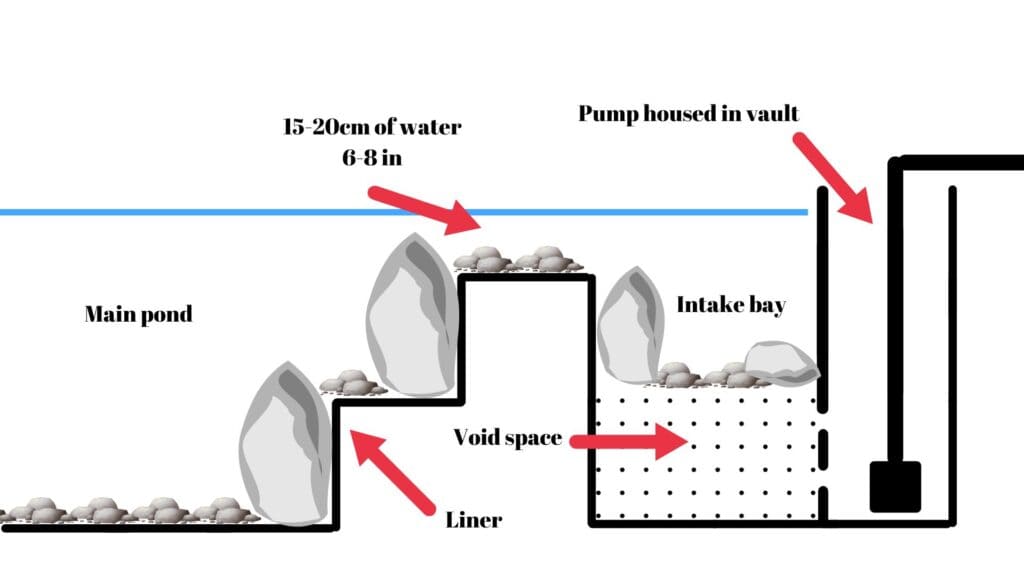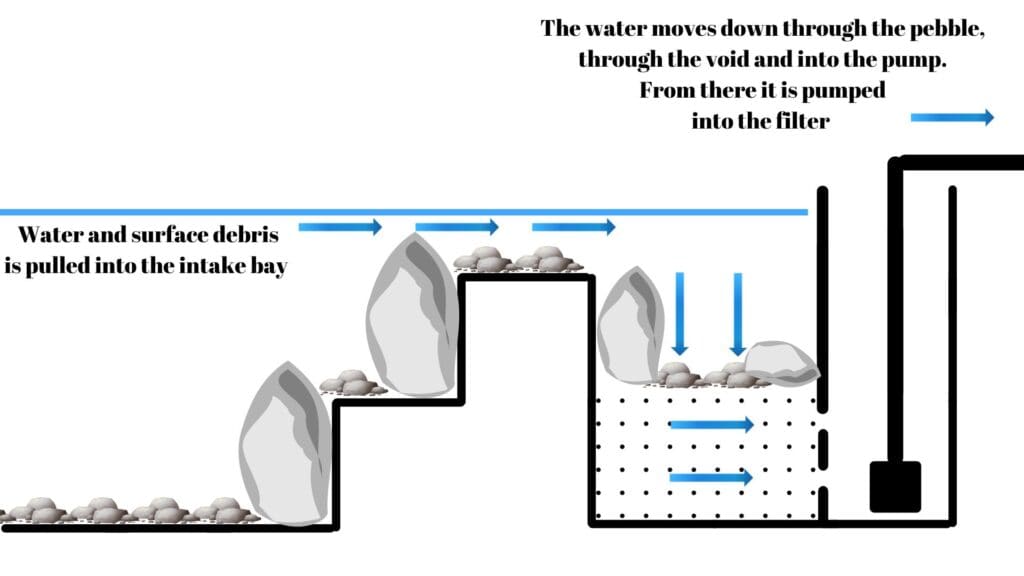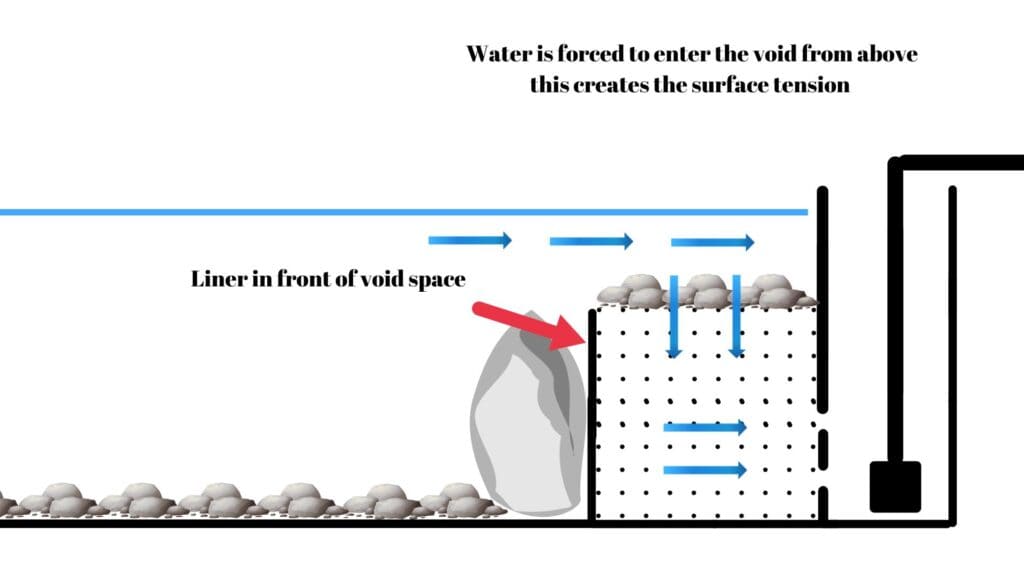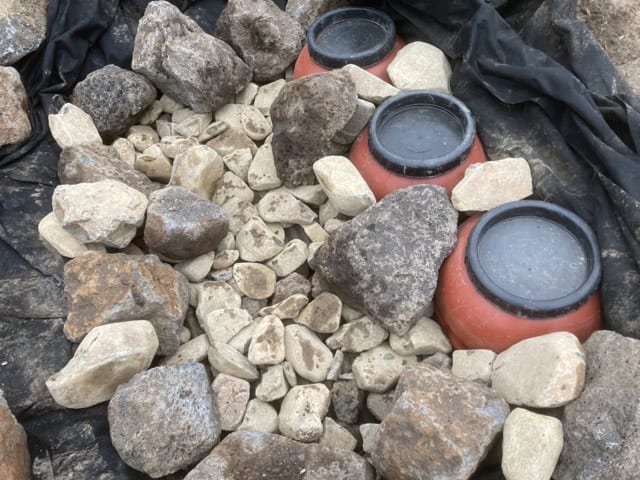An Intake bay is a very useful component to pond filtration. It’s essentially an area of the pond where the pump or pumps are positioned. The intake bay is designed and built in a way that water is pulled into the “bay” over a shallow weir or shelf.
This creates a tension on the waters surface. What this means is that floating debris like leaves, foam, etc is pulled over to the intake bay where it’s easily collected and removed.
Removing these materials prevents them breaking down inside the pond and essentially creating nutrients that algae could otherwise feed on.
The intake bay also acts as a pre-filter protecting the pumps from sucking in bulky debris that could potentially damage your pump, it also prevents small animals from finding their way into the pump.
Adding an intake bay not only provides extra filtration capabilities, it also greatly reduces the overall maintenance on the pond.
When I build my ponds I like to use an intake bay in conjunction with a bog filter to provide me with clear, clean, healthy water and a very easy system to maintain. I do have a handy pdf that talks about all the formulas I use when building my ponds, if you are interested.
Where to position the intake bay
It’s best to position the intake bay at the opposite side of the pond to the biological filter, this will improve overall circulation. If you aren’t sure what a biological filter is you can watch the video below or read this article on biological filtration and the nitrogen cycle.
In my ponds I almost always use a bog filter as my go to biological filter.
Another consideration for the position is wind, if the wind often blows from a certain direction you want to place your intake bay in an area where the wind can assist it.
This can be especially useful if the wind always blows from a certain direction in autumn when the trees drop their leaves. If the pumps are trying to pull water one way but the wind is blowing it another, well it’s not ideal.
Sizing the intake bay
When it comes to the size of the intake bay this is determined by the pumping volume. The general consensus is that the intake bay should be able to hold at least 1 minute of pumping capacity.
So what does that mean? So let’s say that the pumping capacity of the pond is 10,000 liters per hour (approx 2500 gal). That means the intake bay needs to be able to hold around 166 litres of water (approx 42 gal).
How did I reach this figure? Simply take the pumping volume and divide it by 60.
Remember this is the minimum size. It’s better to oversize than undersize, especially if you are expecting lots of debris in the intake bay or you don’t want to be clearing it of debris all the time.
It’s also important to remember that the intake bay is more of a mechanical/ pre-filter, even through the way we will construct it, does have some biological benefits.
But what I’m trying to say is that the biological filter, any circulation jets, or streams and waterfalls will impact the required pumping volume of the pond. Therefore these need to be sized first before the size of the intake bay can be calculated.
This is where my downloadable pdf formula page is helpful.
Construction
To construct the intake bay we will excavate an area that is large enough for the pumping capacity we calculated before. When I build mine I like to use a shelf to create the shallow weir zone.
If you were adding it to an existing pond you could create a false bottom or shelf with matrix blocks. Something like aquablox (amazon link) or an alternative. Here’s a video I made on some cheaper alternatives.
Whichever method you choose the aim of the game is to force the water over a shallow, narrow area to create that surface tension. Hopefully some of the diagrams below will help.



During the construction we will place the pump or pumps in some kind of vault. This will give us easy access to the pumps and also provide an access point during cleaning/ maintenance.
There’s a few different ways the bay can be constructed so it’s going to be easier if you watch the below videos. These show two of my own intake bays using cheap materials and how I put them together.
There’s other ways they could be configured. But basically we want to create surface tension and we want the water to pull down through various sized rock and pebble before being sucked up by the pumps.
The rock and pebble provide the pre-filter and prevent any larger debris from entering the pumps.
The pumps can be connected to whatever you like. They could be going to a bog filter, some jets, maybe a long stream or waterfall.
Just remember that no matter what you should have an appropriately sized biological filter for your pond. An intake bay isn’t the only filter a pond should have, at least in most situations.
Maintaining an intake bay
When we construct an intake bay the right way maintenance is super easy. From time to time you can remove debris from the intake bay. The more often you do this the better.
I’m lazy and my intake bays can go a long time without me netting them. One of the reasons I like to oversize them, there’s no risk that the pumps will be starved of water.
Netting an intake bay only takes a few minutes, if that.
Every now and then though it may be necessary to go a bigger clean. Over time more and more muck will accumulate in the void area, and the rock and pebble. If you start to notice the flow rate of the pumps dropping off, it’s probably a good time for a bigger clean.
The easiest way to do this is to completely drain the intake bay and direct water (under pressure) over the surface so all the muck ends up in your void area and eventually the vault where the pumps are.
You can then use a dirty water pump (amazon link) to suck up all this muck and use it on the garden or lawn.
This is why when I design my intake bays I like to create the shelf in the excavation. This means that I can completely drain the intake bay without draining the entire pond.
Conclusion
If you are lazy like me and you want to spend your days admiring your pond and not maintaining it, an intake bay is a great design element.
It can be made so it blends into the landscape. It also hides and protects the pumps well.

